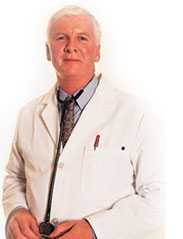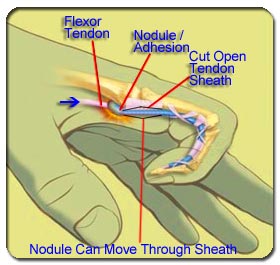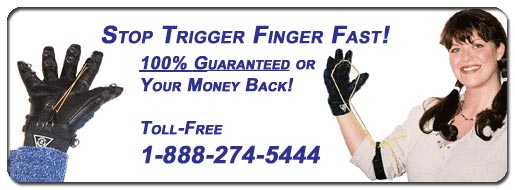
Treatments for Trigger Finger SyndromeThere are not a lot of treatment options for Trigger Finger and Trigger Thumb - leaving only two basic categories; invasive and non-invasive, with only a couple of treatment choices in each. Invasive TreatmentsCortisone Injections: This form of treatment is rather limited due to the extent of soft-tissue damage that can occur with repeated use. No ore than two cortisone injections are recommended as the cortisone has a tendency to cause the tendon to develop a "rubber-like" consistency and ultimately dissolve the tendon over time, resulting in tendon ruptures.. Cortisone is an anti-inflammatory drug that is used to decrease inflammation and swelling of the injured tendon and tendon sheath. This can be of great help to allow rehabilitation to occur while the inflammation and swelling are down, thus correcting the tissue imbalance and eliminating the nodule / adhesion on the tendon. Cortisone keeps the inflammation under control for up to two months, but then the drug wears off and unless the source of the injury has been corrected, the symptoms immediately return. The patient must be careful for the first 21-dsays after an injection as the cortisone causes the tendon to have a consistency like rubber, which can be easily overstressed and overstretched, resulting in an increase in damage to the tendon, resulting in joint laxity (Looseness), and thus further complications.
Surgery: This form of treatment has a poor success rate, often with increased dysfunction post-surgery. The surgical procedure for Trigger Finger and Trigger thumb involves cutting the synovial sheath so that the tendon can move through the joint pulley system without "catching" as the nodule tries to pass through the tendon sheath. The problem is that the "cutting" of the soft-tissues leads to greater scar-tissue development around the affected finger, resulting in further damage and a narrowing around the tendon that causes the nodule / adhesion to still "catch". Non-Invasive TreatmentsMassage: Massage of the affected nodule can help lengthen the involved tissues, causing the tendon to "thin", allowing it to slide through the tendon sheath with greater ease. Ultrasound: This form of treatment can help reduce inflammation and swelling of the nodule / adhesion, thus allowing it to move through the pulley system easier. Stretching: This helps lengthen the flexor tendon and break down the nodule /adhesion on the tendon itself, increasing its ability to move through the tendon sheath. But, stretching alone will not correct the disorder.
Exercises: This is the key, along with stretching, to eliminate Trigger Finger and Trigger Thumb. The important point here is to exercise the right muscle groups. DO NOT PERFORM FLEXION / GRIPPING motions as this stresses the already damaged tendon and increases the irritation of the nodule / adhesion. The exercises that are performed must involved pure finger extension and abduction, without any gripping involved. This form of exercise (FLEXTEND® exercises) actively stretches the flexor tendon(s) while strengthening the extensor tendon(s), helping to increase circulation to the injured finger, break-down scar tissue and thin the tendon, allowing it to pass through the tendon sheath. Massage and ultrasound can be used in conjunction with the FLEXTEND® exercises to speed the recovery process. |
BSI Hours: |

Copyright© - www.TriggerFingerCauses.com - All Rights Reserved |

